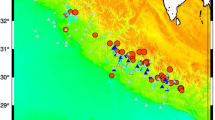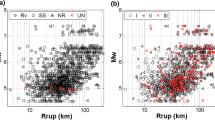Abstract
In the past five years, the local magnitude (ML) 5.8 Gyeongju and ML5.4 Pohang earthquakes have caused significant damage to the southeastern Korean Peninsula. To evaluate the ground motion recorded during these earthquakes, we compared them with the Korean ground motion models (GMMs), also known as the ground motion prediction equations (GMPEs), Next Generation Attenuation of Ground Motions (NGA) GMMs for Western U.S. and Central and Eastern North America. The ground motions exhibit amplification near a period of 0.1 s compared to the predicted spectral accelerations. These amplifications are likely to be attributed to site and topographic effects. The existing GMMs do not account for the topographic amplification which might be prevalent in the mountainous regions of Korea. Therefore, we propose correction factors for the predicted ground motions for various periods in terms of magnitude, source-to-site distance, VS30, and relative elevation. The standard deviation values of the residuals significantly decreased by applying these correction models.














Similar content being viewed by others
Availability of data and material
We acquired the ground motion records from the Korea Meteorological Administration (KMA) at https://necis.kma.go.kr/ (last accessed 28 July 2020). Some of the VS30 data used in this study are available from the corresponding author upon request.
References
Abrahamson NA, Silva WJ, Kamai R (2014) Summary of the ASK14 ground motion relation for active crustal regions. Earthq Spectra 30(3):1025–1055. https://doi.org/10.1193/070913EQS198M
Ahn J-K, Kwak DY, Kim H-S (2021) Estimating VS30 at Korean Peninsular seismic observatory stations using HVSR of event records. Soil Dyn Earthq Eng. https://doi.org/10.1016/j.soildyn.2021.106650
Allen TI, Wald DJ (2007) Topographic slope as a proxy for seismic site-conditions (VS30) and amplification around the globe, in Open-File Report
Ambraseys NN, Douglas J, Sarma SK, Smit PM (2005) Equations for the estimation of strong ground motions from shallow crustal earthquakes using data from Europe and the Middle East: horizontal peak ground acceleration and spectral acceleration. Bull Earthq Eng 3(1):1–53. https://doi.org/10.1007/s10518-005-0183-0
Ashford SA, Sitar N (1997) Analysis of topographic amplification of inclined shear waves in a steep coastal bluff. Bull Seismol Soc Am 87(3):692–700
Ashford SA, Sitar N, Lysmer J, Deng N (1997) Topographic effects on the seismic response of steep slopes. Bull Seismol Soc Am 87(3):701–709
Assimaki D, Kausel E, Gazetas G (2005) Soil-dependent topographic effects: a case study from the 1999 Athens earthquake. Earthq Spectra 21(4):929–966. https://doi.org/10.1193/1.2068135
Boore DM (2010) Orientation-independent, nongeometric-mean measures of seismic intensity from two horizontal components of motion. Bull Seismol Soc Am 100(4):1830–1835. https://doi.org/10.1785/0120090400
Boore DM, Stewart JP, Seyhan E, Atkinson GM (2014) NGA-West2 equations for predicting PGA, PGV, and 5% damped PSA for shallow crustal earthquakes. Earthq Spectra 30(3):1057–1085. https://doi.org/10.1193/070113EQS184M
Bouckovalas GD, Papadimitriou AG (2005) Numerical evaluation of slope topography effects on seismic ground motion. Soil Dyn Earthq Eng 25(7):547–558. https://doi.org/10.1016/j.soildyn.2004.11.008
Bozorgnia Y, Abrahamson NA, Atik LA, Ancheta TD, Atkinson GM, Baker JW, Baltay A, Boore DM, Campbell KW, Chiou BSJ, Darragh R, Day S, Donahue J, Graves RW, Gregor N, Hanks T, Idriss IM, Kamai R, Kishida T, Kottke A, Mahin SA, Rezaeian S, Rowshandel B, Seyhan E, Shahi S, Shantz T, Silva W, Spudich P, Stewart JP, Watson-Lamprey J, Wooddell K, Youngs R (2014) NGA-West2 research project. Earthq Spectra 30(3):973–987. https://doi.org/10.1193/072113EQS209M
Campbell KW (2016) Comprehensive comparison among the Campbell-Bozorgnia NGA-West2 GMPE and three GMPEs from Europe and the Middle East. Bull Seismol Soc Am 106(5):2081–2103. https://doi.org/10.1785/0120160024
Campbell KW, Bozorgnia Y (2014) NGA-West2 ground motion model for the average horizontal components of PGA, PGV, and 5% damped linear acceleration response spectra. Earthq Spectra 30(3):1087–1115. https://doi.org/10.1193/062913EQS175M
Chiou BSJ, Youngs RR (2014) Update of the Chiou and Youngs NGA model for the average horizontal component of peak ground motion and response spectra. Earthq Spectra 30(3):1117–1153. https://doi.org/10.1193/072813EQS219M
Emolo A, Sharma N, Festa G, Zollo A, Convertito V, Park JH, Chi HC, Lim IS (2015) Ground-motion prediction equations for South Korea Peninsula ground-motion prediction equations for South Korea Peninsula. Bull Seismol Soc Am 105(5):2625–2640. https://doi.org/10.1785/0120140296
Farhadi A, Pezeshk S, Khoshnevis N (2018) Assessing the applicability of ground-motion models for induced seismicity application in central and Eastern North America. Bull Seismol Soc Am 108(4):2265–2277. https://doi.org/10.1785/0120170330
Goda K, Atkinson GM (2014) Variation of source-to-site distance for Megathrust subduction earthquakes: effects on ground motion prediction equations. Earthq Spectra 30(2):845–866. https://doi.org/10.1193/080512EQS254M
Goulet C, Bozorgnia Y, Abrahamso N, Kuehn N, Atik L A, Youngs R, Graves R, and Atkinson G (2018) Central and eastern North America gound-motion chracterization - NGA-East final report, in PEER Report No. 2018/08, Pacific Earthquake Engineering Research Center:817
Hashash YMA, Ilhan O, Harmon JA, Parker GA, Stewart JP, Rathje EM, Campbell KW, Silva WJ (2020) Nonlinear site amplification model for ergodic seismic hazard analysis in Central and Eastern North America. Earthq Spectra 36(1):69–86. https://doi.org/10.1177/8755293019878193
Heisey JS, Stokoe KH, Meyer AH (1982) Moduli of pavement systems from spectral analysis of surface waves. Transp Res Rec 852(22–31):147
Huang Y, Li G, Xiong M (2020) Stochastic assessment of slope failure run-out triggered by earthquake ground motion. Nat Hazards 101(1):87–102. https://doi.org/10.1007/s11069-020-03863-7
Idriss IM (2014) An NGA-West2 empirical model for estimating the horizontal spectral values generated by shallow crustal earthquakes. Earthq Spectra 30(3):1155–1177. https://doi.org/10.1193/070613EQS195M
Jee HW, Han SW (2021) Regional ground motion prediction equation developed for the Korean Peninsula using recorded and simulated ground motions. J Earthq Eng: https://doi.org/10.1080/13632469.2021.1871682
Jeong KH, Lee HS (2018) Ground-motion prediction equation for South Korea based on recent earthquake records. Earthq Struct 15(1):29–44
Jo N, Baag C (2003) Estimation of spectrum decay parameter k and stochastic prediction of strong ground motions in southeastern Korea. J Earthq Eng Soc Korea 7(6):59–70
Junn J-G, Jo N-D, Baag C-E (2002) Stochastic prediction of ground motions in southern Korea. Geosci J 6(3):203–214
Kang S, Kim B, Bae S, Lee H, Kim M (2019) Earthquake-induced ground deformations in the low-seismicity region: a case of the 2017 M5.4 Pohang, South Korea, Earthquake. Earthq Spectra 35(3):1235–1260. https://doi.org/10.1193/062318EQS160M
Kang S, Kim B, Cho H, Lee J, Kim K, Bae S, Sun CG (2019) Ground-motion amplifications in small-size hills: case study of Gokgang-ri, South Korea, during the 2017 ML 54 Pohang earthquake sequence. Bull Seismol Soc Am 109(6):2626–2643. https://doi.org/10.1785/0120190064
Kim B, Park K, Baek H (2018) Topographic amplification factors for Japan using 2D finite element analysis. Geotech Earthq Eng Soil Dyn. https://doi.org/10.1061/9780784481462.061
Kim D-S, Manandhar S, Cho HI (2018) New site classification system and design response spectra in Korean seismic code. Earthq Struct 15:1–8
Kim B, Ji Y, Kim M, Lee Y-J, Kang H, Yun N-R, Kim H, Lee J (2020) Building damage caused by the 2017 M5.4 Pohang, South Korea, earthquake, and effects of ground conditions. J Earthq Eng. https://doi.org/10.1080/13632469.2020.1785585
Kiuchi R, Mooney WD, Zahran HM (2019) Ground-motion prediction equations for Western Saudi Arabia. Bull Seismol Soc Am 109(6):2722–2737. https://doi.org/10.1785/0120180302
Korea Meteorological Administration (KMA) (2021) Available at: https://necis.kma.go.kr/
Lee S-J, Chan Y-C, Komatitsch D, Huang B-S, Tromp J (2009) Effects of realistic surface topography on seismic ground motion in the Yangminshan region of Taiwan based upon the spectral-element method and LiDAR DTM. Bull Seismol Soc Am 99(2A):681–693. https://doi.org/10.1785/0120080264
Lee J-M, Park D, Baag C (2000) Stochastic prediction of strong ground motions and attenuation equations in the southeastern Korean Peninsula. In: Proceedings of EESK Conference, Seoul, March:pp 70–77
Park HC, Kim DS (2001) Evaluation of the dispersive phase and group velocities using harmonic wavelet transform. NDT E Int 34(7):457–467. https://doi.org/10.1016/S0963-8695(00)00076-1
Park CB, Miller RD, Xia J (1999) Multichannel analysis of surface waves. Geophysics 64(3):800–808. https://doi.org/10.1190/1.1444590
Park D, Lee J, Baag C, Kim J (2001) Stochastic prediction of strong ground motions and attenuation equations in the southeastern Korean peninsula. J Geol Soc Korea 37(1):21–30
Rai M, Rodriguez-Marek A, Yong A (2016) An empirical model to predict topographic effects in strong ground motion using California small- to medium-magnitude earthquake database. Earthq Spectra 32(2):1033–1054. https://doi.org/10.1193/113014eqs202m
Rai M, Rodriguez-Marek A, Chiou BS (2017) Empirical terrain-based topographic modification factors for use in ground motion prediction. Earthq Sepctra 33(1):157–177. https://doi.org/10.1193/071015eqs111m
Rhie J (2015) A basic study on building ShakeMap database of scenario earthquakes in the Korean Peninsula, KMA, NDSL
Son M, Cho CS, Shin JS, Rhee HM, Sheen DH (2017) Spatiotemporal distribution of events during the first three months of the 2016 Gyeongju, Korea, Earthquake Sequence. Bull Seismol Soci Am 108(1):210–217. https://doi.org/10.1785/0120170107
Stewart JP, Parker GA, Atkinson GM, Boore DM, Hashash YMA, Silva WJ (2020) Ergodic site amplification model for central and eastern North America. Earthq Spectra 36(1):42–68. https://doi.org/10.1177/8755293019878185
Stokoe KH, Wright SG, Bay JA, Roesset JM (1994) Characterization of geotechnical sites by SASW method:pp 15–25
Tafti MF, Hosseini KA, Firouzi E, Mansouri B, Ansari A (2018) Ranking of GMPEs for seismic hazard analysis in Iran using LH, LLH and EDR approaches, Journal of Seismology and Earthquake. Engineering 19(2):139–161
Tavakoli B, Sedaghati F, Pezeshk S (2018) An analytical effective point-source-based distance-conversion approach to mimic the effects of extended faults on seismic hazard assessment. Bull Seismol Soc Am 108(2):742–760. https://doi.org/10.1785/0120170171
U.S. Geological Survey (2021) Available at: https://earthquake.usgs.gov/earthquakes/map/
Veeraraghavan S, Coleman JL, Bielak J (2019) Simulation of site and topographic effects on ground motion in Los Alamos, NM Mesas. Geophys J Int 220(3):1504–1520. https://doi.org/10.1093/gji/ggz448
Villani M, Polidoro B, McCully R, Ader T, Edwards B, Rietbrock A, Lubkowski Z, Courtney TJ, Walsh M (2019) A selection of GMPEs for the United Kingdom based on instrumental and macroseismic datasets. Bull Seismol Soc Am 109(4):1378–1400. https://doi.org/10.1785/0120180268
Wang G, Du C, Huang D, Jin F, Koo RCH, Kwan JSH (2018) Parametric models for 3D topographic amplification of ground motions considering subsurface soils. Soil Dyn Earthq Eng 115:41–54. https://doi.org/10.1016/j.soildyn.2018.07.018
Wang W, Li D-Q, Liu Y, Du W (2021) Influence of ground motion duration on the seismic performance of earth slopes based on numerical analysis. Soil Dyn Earthq Eng 143:106595. https://doi.org/10.1016/j.soildyn.2021.106595
Yun K, Park D, Choi W, Chang C, and Lee D (2005) Development of site-specific ground-motion attenuation relations for Nuclear Power Plant sites and study on their characteristics. In:EESK fall workshop: pp 23–24
Zhang Z, Fleurisson J-A, Pellet F (2018) The effects of slope topography on acceleration amplification and interaction between slope topography and seismic input motion. Soil Dyn Earthq Eng 113:420–431. https://doi.org/10.1016/j.soildyn.2018.06.019
Acknowledgements
We wish to thank anonymous reviewers and Dr. Sean Ahdi for their constructive comments that have greatly helped us going over many details in the original submission.
Funding
This work was supported by a National Research Foundation of Korea (NRF) grant funded by the Korean government (MSIT) (NRF-2020R1C1C1013317) and a grant (2020-MOIS31-013) of the Fundamental Technology Development Program for Extreme Disaster Response funded by Ministry of Interior and Safety (MOIS, Korea).
Author information
Authors and Affiliations
Corresponding author
Ethics declarations
Conflicts of interest
There is no conflict of interest/competing interest.
Additional information
Publisher's Note
Springer Nature remains neutral with regard to jurisdictional claims in published maps and institutional affiliations.
Supplementary Information
Below is the link to the electronic supplementary material.
Rights and permissions
About this article
Cite this article
Park, HJ., Lee, H. & Kim, B. Correction factors for GMMs considering site and topographic effects in South Korea. Bull Earthquake Eng 20, 143–165 (2022). https://doi.org/10.1007/s10518-021-01229-3
Received:
Accepted:
Published:
Issue Date:
DOI: https://doi.org/10.1007/s10518-021-01229-3




